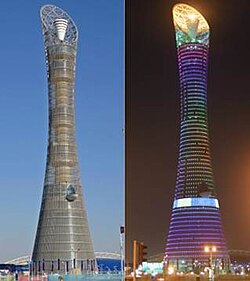Engineering:Aspire Tower
| Aspire Tower | |
|---|---|
 | |
| General information | |
| Type | Hotel |
| Location | Doha, Qatar |
| Coordinates | [ ⚑ ] : 25°15′44.9″N 51°26′41.4″E / 25.262472°N 51.444833°E |
| Construction started | September 9, 2005 |
| Completed | May 22, 2007 |
| Cost | €133,395,000 |
| Height | |
| Architectural | 300 m (980 ft)[1] |
| Top floor | 238 m (781 ft)[1] |
| Observatory | 238 m (781 ft)[2] |
| Technical details | |
| Structural system | Reinforced concrete core, steel skin |
| Floor count | 36[1] |
| Floor area | 35,000 m2 (380,000 sq ft)[2] |
| Lifts/elevators | 17[2] |
| Design and construction | |
| Architect | Hadi Simaan |
| Structural engineer | Arup |
| References | |
| TheTorchDoha.com | |
Aspire Tower, also known as The Torch Doha, is a 300-metre-tall (980 ft) skyscraper hotel located in the Aspire Zone complex in Doha, Qatar. Designed by architect Hadi Simaan and AREP and engineer Ove Arup and Partners,[3] the tower served as the focal point for the 15th Asian Games hosted by Qatar in December 2006.
The tower is currently the second tallest structure and building in Doha and Qatar. In 2023, it was surpassed by the Lusail Plaza Towers. The tower has also been known as Khalifa Sports Tower or Doha Olympic Tower.
Construction and use
The tower was a landmark of the 2006 Asian Games due to its size and proximity to the main venue, the Khalifa International Stadium.
The final form consists of a 1-to-1.8-metre-thick, reinforced-concrete cylinder (the core), varying from 12 to 18 metres in diameter, encircled with radiating networks of cantilevered steel beams on each floor of its building modules. The modules themselves are composed of steel columns, metal decking, concrete slabs and outer tension and compression ring beams, which support glass-paneled outer walls. The bottom of each module is covered with glass fiber reinforced concrete. Beams, as well as steel struts tying all the structural components together, are bolted through the concrete core and hence are anchored into place, transferring vertical loads from perimeter columns and ring beams to the core.[4]
The building was constructed by companies Midmac and BESIX subsidiary Six Construct[5] and was completed in November 2007 at a final cost of €133,395,000.
See also
- Hyperboloid structure
- List of towers
- Aspire Park
References
- ↑ 1.0 1.1 1.2 "Aspire Tower". https://www.skyscrapercenter.com/building/aspire-tower/535.
- ↑ 2.0 2.1 2.2 "Aspire Tower - The Skyscraper Center". Council on Tall Buildings and Urban Habitat. http://skyscrapercenter.com/doha/aspire-tower/.
- ↑ "Sports City Tower, Doha, Qatar". Hadi Simaan. http://www.hadisimaan.com/hospitality/sports_city_tower_doha_qatar/main_picture.html#.
- ↑ "Sports City Tower| Building Types Study | Architectural Record". Archrecord.construction.com. http://archrecord.construction.com/projects/BTS/archives/tallbuildings/08_SCT/default.asp.
- ↑ "Light and fast construction: ArcelorMittal steel solutions for Doha Aspire Tower". https://constructalia.arcelormittal.com/en/case_study_gallery/qatar/light_and_fast_construction_for_aspire_tower.
External links
| Wikimedia Commons has media related to: |
- Hadi Simaan website
- The Torch Doha
- The Aspire Tower: a case study on Constructalia
- Haver & Boecker - Information about the tower
- "Emporis building ID 286515". Emporis. https://www.emporis.com/buildings/286515.
 |


